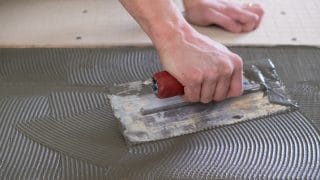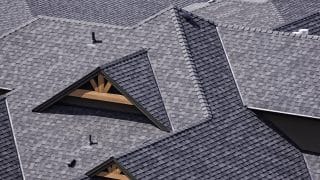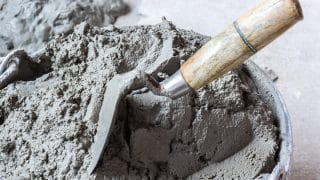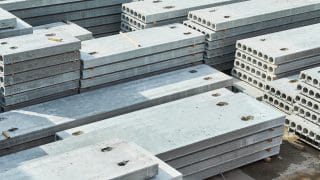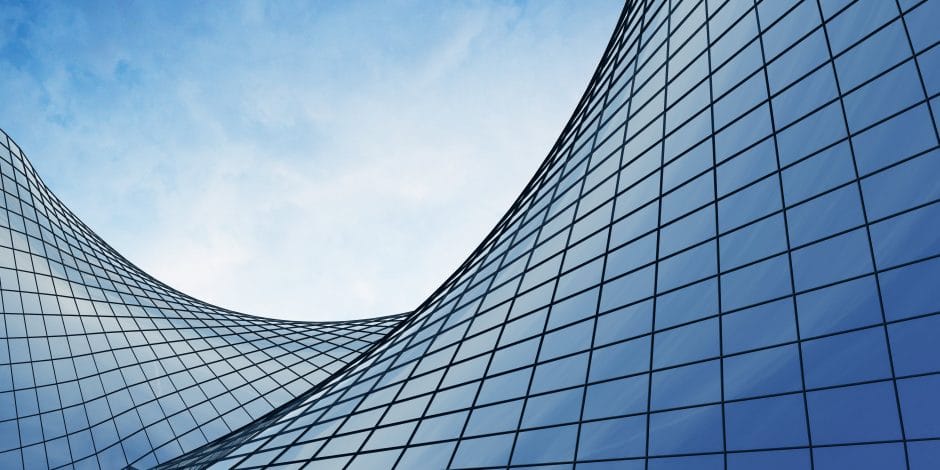
Glass is one of the oldest materials utilized in construction. Aside from use in windows, and as transparent glazing material, it has become an increasingly popular exterior building material.
Glass is made by heating sand or quartz to a high temperature, which produces transparent or translucent molten glass. This molten glass is then molded into a wide range of forms. When it cools to its solid or ambient form, glass is a rigid, stiff material though it is technically an amorphous substance—not quite a solid but not quite a liquid either.
History and development of glass in construction
The history of glass goes back centuries, perhaps millennia. Archaeologists have found evidence of naturally-occuring glass used during the Stone Age, which was likely used by early humans for making weapons.
As time progressed, glass became increasingly used in vessels, like vases and pithers, as well as tiles. This was achieved through glass blowing, a process thought to have begun in 1st Century Europe.
Innovation led to wide scale glassmaking, and its use as a decorative element in buildings. Windows made of cast glass have been found in ruins of ancient Rome. Glassmaking spread throughout Europe, and by the 17th Century, colored glass was popularly used in windows of churches.
Eventually, glass was incorporated as a structural element itself, birthing the concept of glass architecture.
In 1958, a revolutionary method for making sheets of glass was developed by the manufacturing firm Pilkington and Becker. The float glass process was a method that allowed glassmakers to render sheets of glass free of distortion at various thicknesses. The name derives from the process itself—molten glass was floated on molten tin, pulled through flattening rollers and cooled. By instituting a longer cooling time, known as annealing, glassmakers could avoid producing a more brittle material.
Advancement in technology allowed for the production of even stronger types of glass. Soon, glass was no longer solely used as covering for openings in walls, but as material for walls themselves.
Glass is one of the oldest materials utilized in construction. Aside from use in windows, and as transparent glazing material, it has become an increasingly popular exterior building material.
Glass is made by heating sand or quartz to a high temperature, which produces transparent or translucent molten glass. This molten glass is then molded into a wide range of forms. When it cools to its solid or ambient form, glass is a rigid, stiff material though it is technically an amorphous substance—not quite a solid but not quite a liquid either.
History and development of glass in construction
The history of glass goes back centuries, perhaps millennia. Archaeologists have found evidence of naturally-occuring glass used during the Stone Age, which was likely used by early humans for making weapons.
As time progressed, glass became increasingly used in vessels, like vases and pithers, as well as tiles. This was achieved through glass blowing, a process thought to have begun in 1st Century Europe.
Innovation led to wide scale glassmaking, and its use as a decorative element in buildings. Windows made of cast glass have been found in ruins of ancient Rome. Glassmaking spread throughout Europe, and by the 17th Century, colored glass was popularly used in windows of churches.
Eventually, glass was incorporated as a structural element itself, birthing the concept of glass architecture.
In 1958, a revolutionary method for making sheets of glass was developed by the manufacturing firm Pilkington and Becker. The float glass process was a method that allowed glassmakers to render sheets of glass free of distortion at various thicknesses. The name derives from the process itself—molten glass was floated on molten tin, pulled through flattening rollers and cooled. By instituting a longer cooling time, known as annealing, glassmakers could avoid producing a more brittle material.
Advancement in technology allowed for the production of even stronger types of glass. Soon, glass was no longer solely used as covering for openings in walls, but as material for walls themselves.
Types of glass used in construction
With multiple new processes and technologies for making glass, there are many different types of glass used in construction today, each with unique characteristics.
- Sheet or flat glass. Sheet glass is produced by pulling molten glass through rollers to affect a flat finish. The result is a low-cost, undistorted glass.
- Float glass. Sometimes known as soda-lime glass, float glass is made from sodium silicate and calcium silicate. As mentioned, to make it, molten glass is floated on a bed of molten tin, rendering a flat, clear surface free of distortions.
- Laminated glass. Laminated glass is made of layers of ordinary glass bonded by a flexible, clear polymer. It is essentially a sandwich made of two or more pieces of glass. The polymer between the two sheets prevents the glass from actually shattering into dangerous shards if the glass breaks. This type of glass is commonly used for car windshields as a safety measure, but is also used in construction for windows particularly skylights.
- Energy-efficient glass. Energy-efficient glass is manufactured by glazing float glass with a special coating on one side. The coating allows solar energy to pass through the glass going in one direction, and minimizes thermal energy transfer in the opposite.
- Wired glass. Wired glass has metal mesh embedded in it. This holds the glass together in the event of cracking—but unlike laminated or shatterproof glass, this does not stop broken pieces from forming sharp edges. Wired glass holds together during a fire, hence why this type of glass was frequently used in schools and other public buildings. Wired glass fell out of favor as other technologies replaced it.
- Tinted glass. Tinted glass is simply glass that is colored. Certain types of ions, depending on the desired shade, are added to the normal glass mix to produce tinted glass. Color generally does not affect the integrity of the glass.
- Tempered glass. Toughened glass or tempered glass is a type of glass that is heated and quickly cooled, which puts the outer surface into compression. When tempered glass breaks, it breaks into much smaller pieces that are safer than large shards. Tempered glass is used extensively throughout the construction industry for glass doors, shower doors, countertops, and windows because of its superior impact and heat resistance..
- Glass blocks. Glass blocks are bricks of glass manufactured as two separate halves which are pressed together and annealed while still molten. They function similarly to clay bricks, but without the opacity.
Advantages of using glass in buildings
There are many advantages to incorporating glass into a building’s structure, including:
- Transparency. Glass is a unique, clear material that allows light (especially natural light) to pass through. This allows rooms behind glass to be thoroughly, pleasingly illuminated. Beyond aesthetic value, it reduces electricity bills by negating the need for artificial light at certain times of day.
- Easy to clean. Glass has a glossy, smooth finish, and can subsequently be cleaned efficiently.
- Waterproof. Prolonged exposure to water does not result in significant damage to glass.
- Recyclable. Glass is 100% recyclable and does not degrade during the recycling process. It can therefore be recycled more times without compromising the quality or purity of the glass.
- UV stable. Glass is not affected by ultraviolet radiation, and will not crack, discolor, or degrade under prolonged sun exposure.
- Insulation. Glass building material is a superb electrical insulator. It does not conduct electricity, ensuring safety from hazards. Thus, glass can be readily used in lighting fixtures and other electrical appliances.
Disadvantages of using glass in buildings
Despite its many advantages, there are a few disadvantages to using glass in the construction of buildings.
- Cost. Glass manufacturing can be energy-consuming due to the high temperature needed to produce material.
- Brittleness. Though formulas can be tweaked to strengthen it, glass is, compared to other substances, an inherently brittle material. If subjected to significant stress, it often breaks. Cracked pieces of glass can be very sharp, which increases the risk of injury on the job site or in the finished building.
- Maintenance. In more dust-prone and humid regions, particles may adhere to a glass surface, causing it to look dirty and negatively impacting internal lighting as well as clarity.
MT Copeland offers video-based online classes that give you a foundation in construction fundamentals with real-world applications, like how the commercial construction industry works today. Classes include professionally produced videos taught by practicing craftspeople, and supplementary downloads like quizzes, blueprints, and other materials to help you master the skills.


